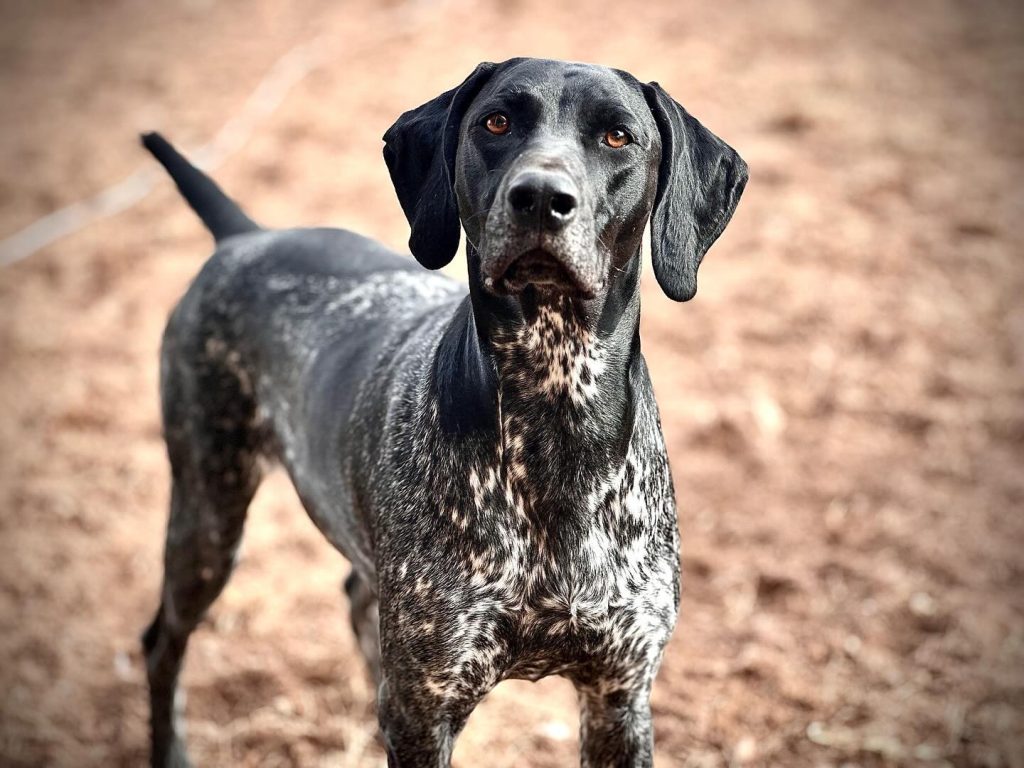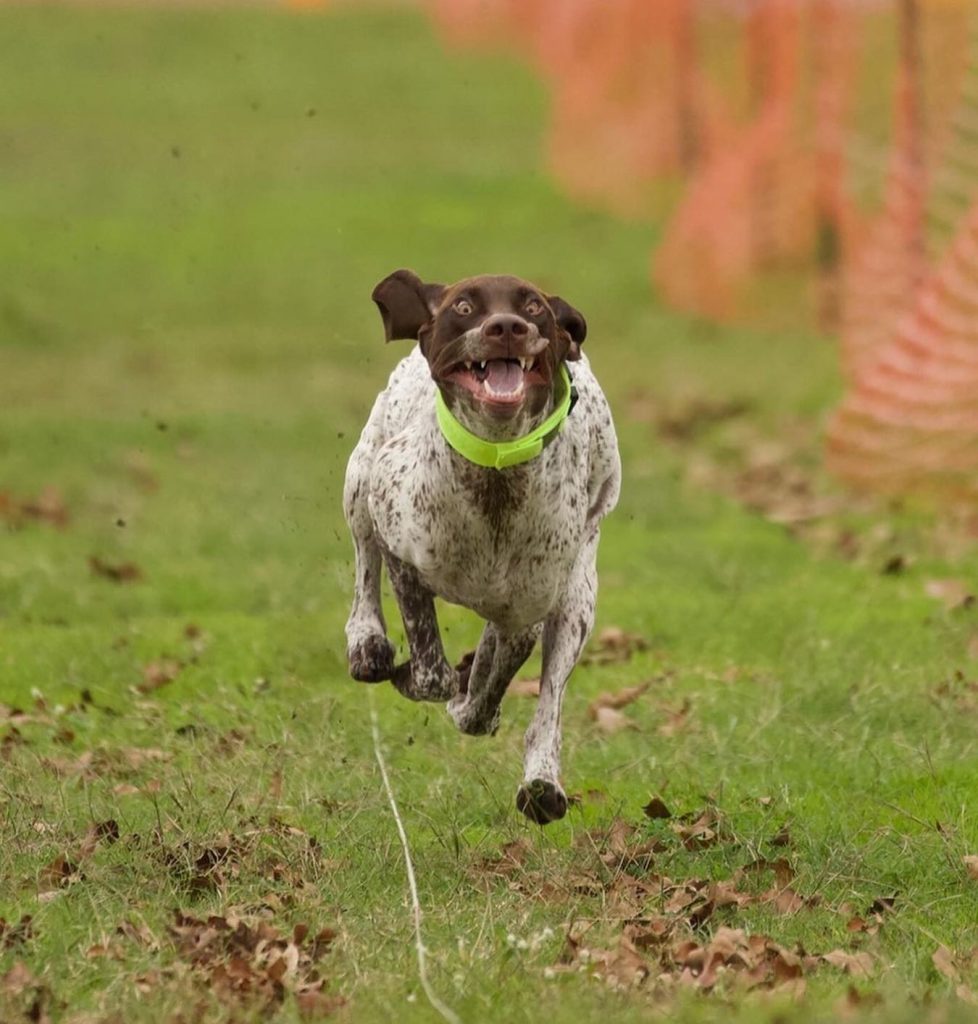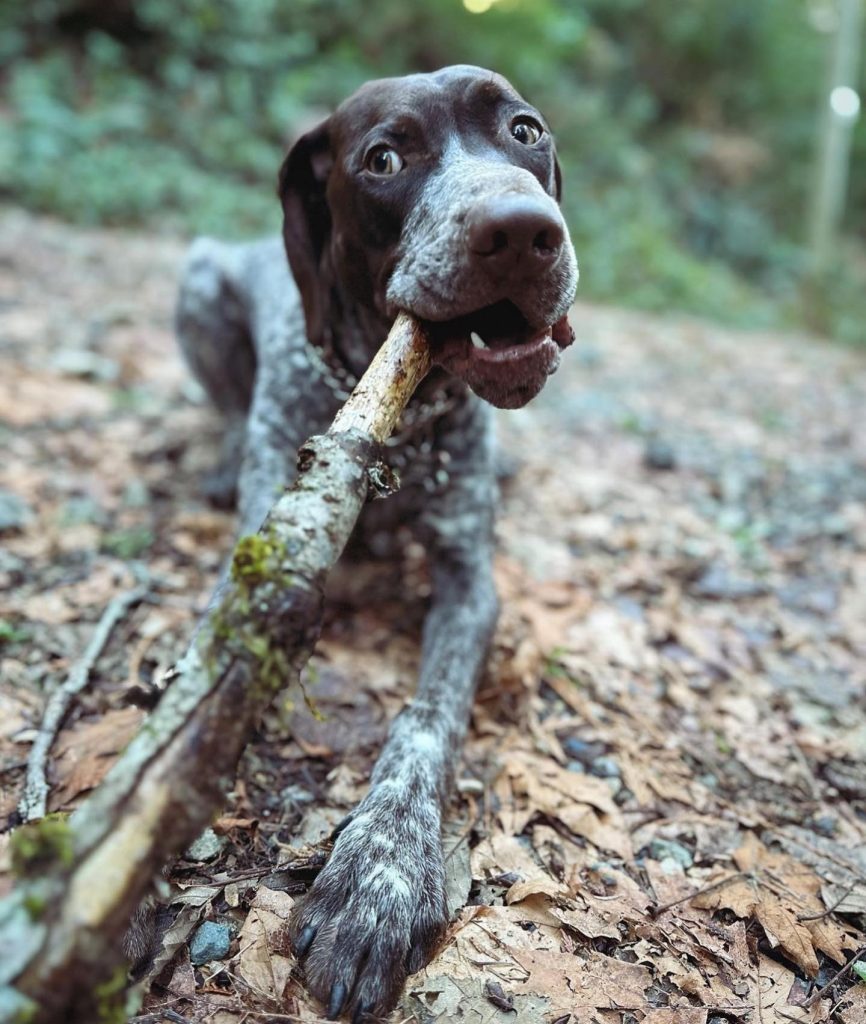
The German Shorthaired Pointer (GSP) is a versatile medium-sized hunting dog breed known for intelligence, energy, and loyalty. This breed is highly regarded by hunters and families alike due to its keen sense of smell, strong work ethic, and friendly nature. The German Shorthaired Pointer is always eager to please and ready for adventure, whether in the field or at home.
Quick Overview GSP
The German Shorthaired Pointer dog breed is a medium to large-sized dog breed that stands out for its sleek, streamlined build and distinctive coat pattern. They are quick learners, making them excellent companions for various activities beyond hunting, such as hiking, running, and competitive sports. Their short coat, which comes in combinations of liver and white, is easy to maintain, adding to their appeal as family pets.
Origin and History of the German Shorthaired Pointer Dog Breed
The German Shorthaired Pointer’s origins trace back to the 19th century in Germany, where breeders aimed to create a versatile hunting dog that could perform well in water and on land. They were developed from a mix of Spanish Pointers, Bloodhounds, and local German hunting dogs, resulting in a breed that excelled in tracking, pointing, and retrieving games. The adaptability and skill of this breed quickly spread its popularity across Europe and later to the United States, where it remains a favored choice for hunters and active families over different breeds.
Key Characteristics & Breed Standards
The German Shorthaired Pointer, also known as German Pointers, is celebrated for versatility, intelligence, and athleticism. These characteristics are deeply ingrained in the breed’s standards, reflecting their hunting heritage and making them exceptional companions in the field and at home.
Breed Traits and Temperament, Including Prey Drive
Personality
GSPs possess a vibrant and pleasant personality. They are known for their boundless energy and enthusiasm, matched by a keen intelligence and an eagerness to please. This combination makes them excellent hunting partners for German hunters and affectionate family members who form strong bonds with their owners.
Adaptability
Training a GSPS often highlights their remarkable adaptability. They are well-suited to various environments and situations, from active outdoor adventures to relaxed family settings. Their ability to adjust to different circumstances and resilient nature makes them ideal for seasoned dog owners and those new to the breed.
Trainability
Their intelligence and desire to please come to the forefront when training German Shorthaired Pointers. These dogs are quick learners who respond well to positive reinforcement and consistent training. Early socialization and obedience training are crucial for harnessing their energy positively and ensuring they grow into well-mannered adults.
Physical Attributes
Height and Weight
The German Shorthaired Pointer (GSP) is a medium to large-sized breed, with males typically standing between 23 and 25 inches at the shoulder and females slightly smaller, ranging from 21 to 23 inches. Their weight varies, with males usually weighing between 55 and 70 pounds and females between 45 and 60 pounds, reflecting their muscular and athletic build.
Coat Type and Colors
The coat of a German Shorthaired Pointer is short, thick, and water-resistant, ideal for their work in the field as a pointing dog. Their distinctive coat patterns range from solid liver to a combination of liver and white, including spotted, ticked, or roan variations. This low-maintenance coat is one of their defining features, requiring minimal grooming.
Grooming Needs
Despite their low-maintenance coat, German Shorthaired Pointers do shed, especially during the changing seasons. Regular brushing, once or twice a week, helps manage shedding and keeps their coat healthy. Other grooming needs include regular nail trimming, ear cleaning, and dental care to prevent common health issues.
Health and Wellness
Ensuring the health and wellness of a German Shorthaired Pointer is pivotal for their longevity and quality of life. Like all breeds, they have specific health considerations that owners should be aware of, alongside nutritional and exercise needs that are crucial for maintaining their well-being.
General Health Information
German Shorthaired Pointers are generally healthy dogs known for their longevity and vitality. However, proactive health management and regular veterinary care are essential to identify and address issues early on.
Potential Health Concerns
While German Shorthaired Pointers are robust, they can be predisposed to specific health conditions:
- Hip Dysplasia: A genetic condition where the thigh bone doesn’t fit snugly into the hip joint, which can lead to arthritis.
- Epilepsy: A neurological disorder that can cause seizures.
- Bloat (Gastric Torsion): A life-threatening condition where the stomach distends and twists, requiring immediate veterinary attention.
- Cardiac Disorders: Including Aortic Stenosis and Cardiomyopathy, which affect the heart’s function.
- Skin Conditions: Such as allergies and skin infections, often due to their outdoor activities.
Recommended Health Tests
To ensure the health and longevity of German Shorthaired Pointers, the following health tests are recommended:
- Hip Evaluation: To screen for hip dysplasia.
- Ophthalmologist Evaluation: To check for inherited eye diseases.
- Cardiac Exam: To detect any heart abnormalities early on.
Nutrition Guidelines

Proper nutrition is fundamental to the health of a German Shorthaired Pointer. Their diet should be tailored to their age, size, and activity level:
- High-Quality Dog Food: Either commercially manufactured or home-prepared with your vet’s supervision and approval.
- Protein-Rich Diet: To support their muscular build and high energy levels.
- Proper Portion Control: To prevent obesity, a measured diet and a regular feeding schedule are essential.
- Access to Fresh Water: Ensure they have continuous access to clean, fresh water, especially after exercise.
Exercise Requirements
The German Shorthaired Pointer’s high energy levels and stamina necessitate regular, vigorous exercise:
- Daily Physical Activity: At least an hour of vigorous exercise daily, such as running, swimming, or fetching games.
- Mental Stimulation: Puzzle toys, training sessions, and interactive games to keep their mind engaged.
- Safe Off-Leash Play: They can run freely in a securely fenced area or dog park.
- Structured Activities: Participating in dog sports like agility, tracking, or flyball can provide physical and mental challenges.
Incorporating these German shorthaired pointer training tips into their routine addresses their physical needs and aids in behavioral development, making training a crucial aspect of their daily regimen. Regular exercise keeps them physically fit and mentally sharp, reducing the likelihood of behavioral issues stemming from boredom or excess energy.
Living With a GSPS
Integrating a German Shorthaired Pointer into your home is a rewarding experience that comes with its unique set of considerations. Their adaptable nature makes them excellent companions for various households, but understanding their needs and characteristics is critical to a harmonious living environment.
Compatibility with Families
German Shorthaired Pointers are known for their affectionate and friendly nature, making them fantastic family pets. They thrive in environments where they can form strong bonds with their family members and participate in daily activities.
Good With Children
These dogs are particularly good with children, thanks to their playful and gentle demeanor. Their patience and energy make them excellent playmates for kids, provided interactions are supervised, especially with younger children, to ensure safety for both the child and the dog. As is the case with any breed, teaching children how to interact with dogs respectfully and safely is crucial.
Good With Other Pets
German Shorthaired Pointers can also get along well with other pets, including dogs and cats, primarily if raised with them from puppyhood. Their hunting instincts may kick in with smaller animals, so early socialization and training are essential to teach them appropriate behavior around other household pets.
Housing Considerations
While German Shorthaired Pointers are adaptable to various living situations, certain factors should be taken into account to ensure their well-being and happiness.
Apartment Living Adaptability
Living in an apartment with a German Shorthaired Pointer is possible, provided their exercise and mental stimulation needs are met. They are active dogs who require sufficient daily exercise to prevent boredom and destructive behaviors. Owners living in apartments need to commit to regular, vigorous exercise routines and should have access to nearby parks or open spaces where the dog can run freely and safely.
Exercise Needs and Activities

The exercise needs of a German Shorthaired Pointer are not just a preference but a necessity for their physical and mental health. These dogs excel in activities that challenge them both physically and mentally, such as long runs, hikes, swimming, and fetch games. Engaging in dog sports like agility, flyball, or obedience trials can also provide excellent outlets for their energy and intelligence.
Incorporating training sessions into their exercise routine can enhance the bond between the dog and owner while reinforcing good behavior. It is essential to understand how to train a German Shorthaired Pointer, especially during their formative puppy years. German Shorthaired Pointer puppy training should focus on basic obedience, socialization, and establishing a routine with plenty of exercises and mental stimulation. This foundation ensures that they grow into well-adjusted and behaved adults, making living with them a joy for the entire family.
Training, Socialization, and the Importance of Mental Stimulation
Training and socialization are pivotal aspects of raising a German Shorthaired Pointer. Their keen intelligence and inherent eagerness to learn make the training process rewarding for both the dog and the owner. Proper socialization from a young age ensures they become well-rounded adults capable of adapting to various situations with ease.
Training Basics
Easy To Train
Are German Shorthaired Pointers easy to train? The answer is a resounding yes, primarily due to their intelligence and desire to please their owners. These traits make them highly responsive to training from an early age. Starting training sessions early is crucial, as their energetic nature can quickly turn to mischief without proper guidance. Positive reinforcement techniques, such as treats and praise, are particularly effective, encouraging them to repeat desired behaviors.
Intelligence and Learning Capacity
The intelligence and learning capacity of German Shorthaired Pointers is among their most notable traits. They have a remarkable ability to understand commands and learn new tasks, making them excellent hunting dogs and versatile in various canine sports and activities. Their prowess in fields like German shorthaired pointer agility showcases their physical ability and mental acuity. Training sessions should be varied and engaging to keep them interested, taking advantage of their natural agility and intelligence.
Socialization Tips
Proper socialization is critical to ensuring that your German Shorthaired Pointer grows into a well-adjusted adult, comfortable in various settings and situations.
Friendliness Towards Strangers
German Shorthaired Pointers are generally friendly and outgoing, but like all dogs, they benefit from early socialization to ensure positive interactions with strangers. Exposure to different people, environments, and situations from a young age helps them develop confidence and reduces the likelihood of fear or aggression. Regular walks in the park, visits to dog-friendly cafes, and playdates with other dogs can provide valuable socialization opportunities.
Dealing with Prey Drive
Given their hunting heritage, German Shorthaired Pointers have a strong prey drive, which can pose challenges in certain social situations, especially when encountering small animals. Training them to manage this instinct is crucial for their safety and the well-being of other animals. Commands such as “leave it” or “come” are essential for redirecting their focus and ensuring they remain under control. Consistent training and reinforcement of these commands, combined with leash training and supervised off-leash time in secure areas, can help manage their prey drive in social settings.
In conclusion, training and socializing a German Shorthaired Pointer requires a commitment to consistent, positive reinforcement and an understanding of their unique traits. Their agility, intelligence, and trainability make the process enjoyable and deeply rewarding, leading to a strong, lifelong bond between the dog and its owner.
Grooming and Care
Proper grooming and care are essential to maintain the health and happiness of a German Shorthaired Pointer throughout their life stages. These aspects are critical considering their active lifestyle and coat characteristics.
Coat and Shedding Management
- Regular brushing, at least once a week, helps remove loose fur and minimize shedding.
- More frequent brushing may be necessary to manage the increased shedding during shedding seasons.
- Bathing should be done as needed, using dog-specific shampoo to keep their coat healthy without stripping natural oils.
Dealing with Drooling

- German Shorthaired Pointers are not known for excessive drooling.
- Regular checks for oral health issues can prevent unexpected drooling, which may indicate a problem.
Exercise Needs for an Active Dog
- Daily vigorous exercise is crucial for their physical and mental well-being.
- Activities should include running, swimming, or fetching to match their high energy levels.
- Adapting exercise routines to accommodate the German shorthaired pointer life stages ensures they remain active and healthy.
Finding a German Shorthaired Pointer
When adding a German Shorthaired Pointer to your family, making an informed decision is crucial. This involves considering various factors to ensure the dog’s characteristics align with your lifestyle and expectations.
Choosing the Right Dog
Factors to Consider
Selecting the right German Shorthaired Pointer involves evaluating your living situation, activity level, and time to dedicate to training, socialization, and exercise. Understanding the breed’s needs and energy levels ensures a good match. Prospective owners should also consider the dog’s age, as puppies require considerable time and effort for training, while older dogs may be a better fit for those looking for a less demanding companion.
Where to Find Puppies or Rescue Dogs
When looking for a German Shorthaired Pointer, reputable breeders, and rescue organizations are both viable options. Reputable breeders provide health clearances and are transparent about the puppy’s lineage, ensuring a healthy start to life. Rescue organizations offer the opportunity to provide a loving home to a dog in need, often with the benefit of knowing the dog’s personality and any special requirements. Regardless of the source, due diligence ensures a responsible and ethical choice.
Breed Highlights and Fun Facts
The German Shorthaired Pointer is a breed full of surprises and noteworthy traits that make it stand out among the canine community. From its versatile hunting skills to its engaging personality, there’s much to learn and admire about these dogs.
Did You Know?
- Versatile Hunters: Originally bred for hunting, German Shorthaired Pointers are adept at pointing and retrieving, making them versatile hunters on land and water, much like their ancestors, the Old Spanish Pointer.
- Athletic Competitors: They excel in various dog sports, including agility, flyball, and dock diving, showcasing their athletic abilities and intelligence.
- Family Companions: Beyond their hunting prowess, German Shorthaired Pointers are affectionate and loyal family pets known for their strong bond with their human companions.
- Noble Origins: The breed’s development in the 19th century aimed to create an all-purpose hunting dog, combining traits from various breeds for the ideal balance of strength, speed, and scenting ability.
Similar Breeds and Comparisons

- English Pointer: Similar in name and hunting skills, the English Pointer is another breed known for its pointing abilities, though it tends to have a more reserved personality than the German Shorthaired Pointer.
- Vizsla: Often compared due to their similar appearances and temperaments, Vizslas share the German Shorthaired Pointer’s love for activity and companionship, but they have a distinct golden rust coat.
- Weimaraner: Sharing a common ancestry, Weimaraners and German Shorthaired Pointers are both high-energy, intelligent breeds, though Weimaraners are larger and have a distinctive silver-gray coat.
Each of these breeds shares certain traits with the German Shorthaired Pointer, yet they each possess unique characteristics that set them apart, making the German Shorthaired Pointer a distinct and cherished breed in the world of dogs.
